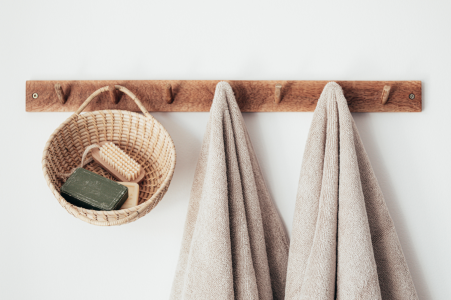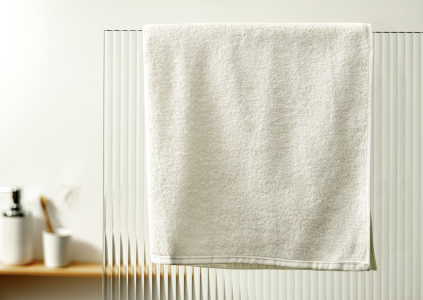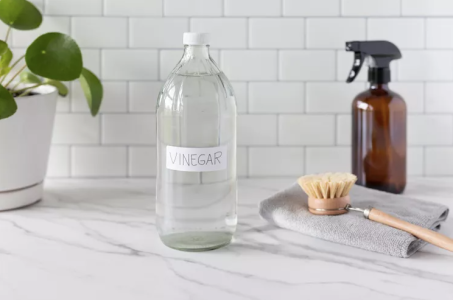Shocking Expert Revelation: This Common Towel Habit Could Be Causing Mould in Your Home!
By
VanessaC
- Replies 1
It can be hard to keep mould out of your home, particularly in those persistently damp areas like the bathroom. And while you normally think of things like airing the room out and using the fan while in the shower, there’s one more common habit that the experts say we’re doing wrong – hanging our damp towels.

Brian Karr, the co-founder of mould removal and inspection business We Inspect, recently revealed this gross reality in a reel on his social media page (which is full of other preventative and removal tips). He shared the most important advice for preventing mould: don’t hang your wet towels on wall hangers that are next to a dry wall.
'Think about it, a dry wall is like hard paper – and if you hang your wet towels on it you’re inviting mould onto your walls' he said. He notes that about 50% of the time he inspects homes for mould, he finds it growing on the back of the wallpaper, away from the surface.
So where should you put your damp towels then? Karr recommends drying them before you put them on a wall hanger, suggesting towels should be hung over the shower or bath. Don’t have a shower curtain rod or bath? One follower suggested getting a free-standing towel rack in the bathroom.
As with many things, prevention is key, and there are other steps you can take to avoid mould and mildew in the bathroom, such as leaving bathroom doors and windows open as much as possible and to squeegee water off the tiles and glass after showering.
DIY Methods for Preventing and Removing Mould
Alongside the insightful tips from the experts, we'd also like to introduce some cost-effective do-it-yourself methods to keep these pesky intruders at bay.
Firstly, and perhaps most obviously, don't let moisture linger! Whether it's a wet towel or a spill, make sure you mop up excess water promptly. This also applies after a hot, steamy Aussie shower. Consider using moisture-absorbing products like silica gel sachets in your cabinets, wardrobes, and those smaller spaces prone to dampness, as these can be real mould hotspots. And like we always say, ‘let it air out!’ Whether it's your laundry or the bathroom after a shower, fresh air is like mould kryptonite.
For a more proactive approach, household vinegar serves as an impressive foe against these unwelcome fungi. Simply mix equal parts of white vinegar and water in a spray bottle and voila! You have your very own mould-busting solution. Spray it on affected areas, leave it for an hour and then clean it off with a damp cloth. Just remember, vinegar has a pungent smell which will dissipate after a while, so no need to worry about your home smelling like a fish and chip shop.
Lastly, if you find a small mould patch creeping up, you can try carefully applying a mildew-resistant paint. Not only is it easy to use, but it also adds a layer of protection to your walls. Remember, it's important to clean the mould properly before applying the paint, otherwise, you're merely hiding the problem, not solving it.
All these tips and tricks, while helpful, are focused on preventing or tackling minor mould growth. If you see a larger growth or notice a damp smell that just won't go away, it may be time to call in some professional reinforcements. After all, an ounce of prevention is indeed worth a pound of cure – or in our case, mould!
Unfortunately, if mould and mildew has already taken hold, it’s time to call in the professionals. Regardless, our advice is to always give your towels a good hang before placing them anywhere else, and to air the room out too. Mould can be a nasty business if you don’t stay on top of it!
Do you have your own ways of dealing with mould? Share them with us in the comment section below!

Brian Karr, co-founder of We Inspect, is warning Aussies not to hang wet towels on wall hangers that are next to a dry wall. Image source: Karolina Grabowska from pexels
Brian Karr, the co-founder of mould removal and inspection business We Inspect, recently revealed this gross reality in a reel on his social media page (which is full of other preventative and removal tips). He shared the most important advice for preventing mould: don’t hang your wet towels on wall hangers that are next to a dry wall.
'Think about it, a dry wall is like hard paper – and if you hang your wet towels on it you’re inviting mould onto your walls' he said. He notes that about 50% of the time he inspects homes for mould, he finds it growing on the back of the wallpaper, away from the surface.
So where should you put your damp towels then? Karr recommends drying them before you put them on a wall hanger, suggesting towels should be hung over the shower or bath. Don’t have a shower curtain rod or bath? One follower suggested getting a free-standing towel rack in the bathroom.
As with many things, prevention is key, and there are other steps you can take to avoid mould and mildew in the bathroom, such as leaving bathroom doors and windows open as much as possible and to squeegee water off the tiles and glass after showering.
DIY Methods for Preventing and Removing Mould
Alongside the insightful tips from the experts, we'd also like to introduce some cost-effective do-it-yourself methods to keep these pesky intruders at bay.
Firstly, and perhaps most obviously, don't let moisture linger! Whether it's a wet towel or a spill, make sure you mop up excess water promptly. This also applies after a hot, steamy Aussie shower. Consider using moisture-absorbing products like silica gel sachets in your cabinets, wardrobes, and those smaller spaces prone to dampness, as these can be real mould hotspots. And like we always say, ‘let it air out!’ Whether it's your laundry or the bathroom after a shower, fresh air is like mould kryptonite.
For a more proactive approach, household vinegar serves as an impressive foe against these unwelcome fungi. Simply mix equal parts of white vinegar and water in a spray bottle and voila! You have your very own mould-busting solution. Spray it on affected areas, leave it for an hour and then clean it off with a damp cloth. Just remember, vinegar has a pungent smell which will dissipate after a while, so no need to worry about your home smelling like a fish and chip shop.
Lastly, if you find a small mould patch creeping up, you can try carefully applying a mildew-resistant paint. Not only is it easy to use, but it also adds a layer of protection to your walls. Remember, it's important to clean the mould properly before applying the paint, otherwise, you're merely hiding the problem, not solving it.
All these tips and tricks, while helpful, are focused on preventing or tackling minor mould growth. If you see a larger growth or notice a damp smell that just won't go away, it may be time to call in some professional reinforcements. After all, an ounce of prevention is indeed worth a pound of cure – or in our case, mould!
Unfortunately, if mould and mildew has already taken hold, it’s time to call in the professionals. Regardless, our advice is to always give your towels a good hang before placing them anywhere else, and to air the room out too. Mould can be a nasty business if you don’t stay on top of it!
Do you have your own ways of dealing with mould? Share them with us in the comment section below!










